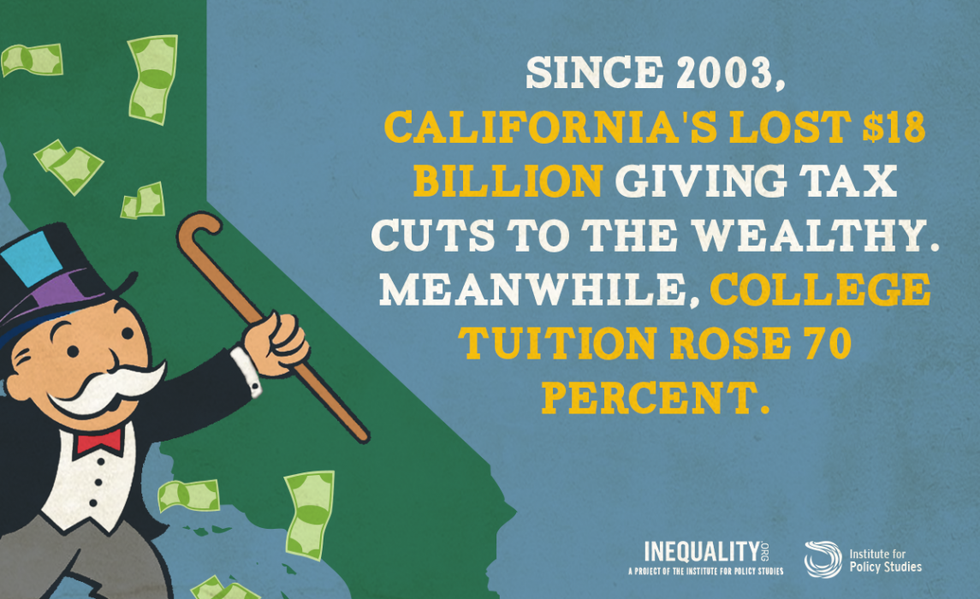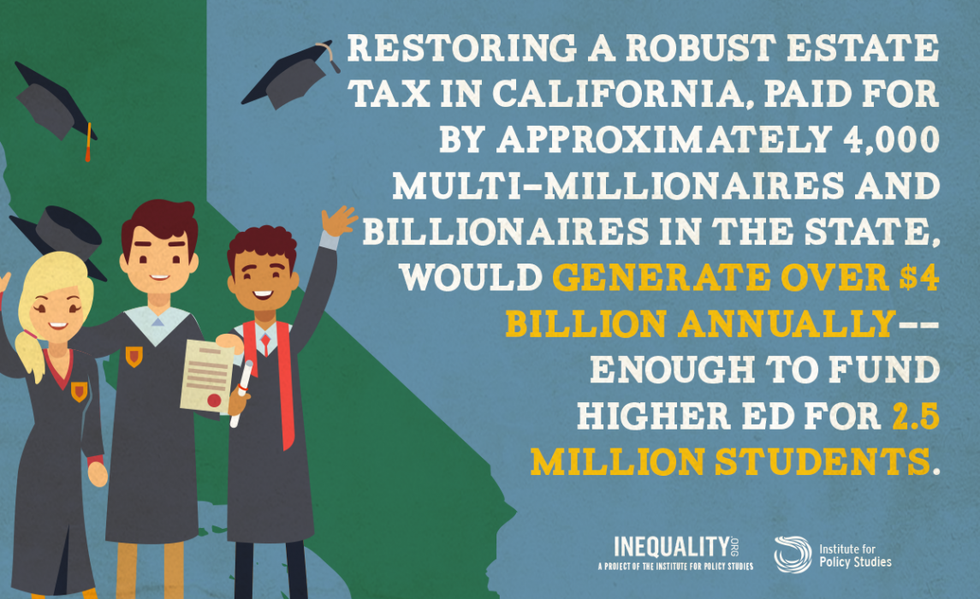
"There was a time in the not-too-distant past when Californians could attend top tier research universities as well as state and community colleges without incurring student debt." (Photo: Joe Brusky/flickr/cc)
Restoring Opportunity: Taxing Wealth to Fund College For All in CA
New report finds initiative to restore the California state estate tax could make college accessible for millions of students in the state.
Decades of regressive tax cuts and subsequent budget cuts have undermined the rosy reality of higher education in California. Resulting tuition increases have shifted the cost of college on to students and their parents. Restoring Opportunity: Taxing Wealth to Fund College for All in California found that $18 billion in revenue has been lost to tax cuts for wealthy Californians since 2003, and over that same period, college tuition increased by 70 percent after accounting for inflation.
This report outlines the transition from a debt-free public higher education system to one where declining state support has led to a surge both in the number of students taking on debt and in the amount of debt they take on.
Key findings of this report include:
- Due to the repeal of the California state estate tax, the state lost $18 billion in revenue between 2003 and 2016 that would have been paid exclusively by multi-millionaires and billionaires.
- Over that same period, average in-state tuition and fees for public colleges and universities went up nearly 70 percent after accounting for inflation.
- Average student debt for graduates of public colleges and universities rose 17 percent, after accounting for inflation.
- Restoring a robust estate tax in California would generate over $4 billion annually, paid for by approximately 4,000 multi-millionaires and billionaires in the state -- enough to fund higher ed for 2.5 million students.
- As the state population and college student population became more racially diverse, state support declined and the burdens of paying for college fell more heavily on students and their families.
There was a time in the not-too-distant past when Californians could attend top tier research universities as well as state and community colleges without incurring student debt. Up until the 1970s, public higher education in California was virtually free. The tradition of making high-quality public colleges and universities accessible to students of all economic backgrounds is threatened by tax cuts for the wealthy and underfunding of higher education.
The estate tax remains among the most progressive ways for states to generate revenue. Looking into the future, the report finds if California does not take action, the state stands to lose another $5-6 billion by 2019. These are funds that could fill a substantial hole in the state's unmet commitment to public higher education.
Now nationally, over 44 million households are holding student debt totaling over $1.4 trillion, surpassing credit card debt and auto loans. Average per student debt for last year's graduating class exceeded $37,000.
The organization, California College for All, has generated a ballot initiative campaign focused on the 2020 election to restore debt-free higher education to California, funded by the restoration of the state estate tax. This is a model other states can use to give their residents access to higher education without the burden of untenable student debt. There are currently multiple College for All proposals under consideration at the federal level championed by Senators Bernie Sanders and Brian Schatz to greatly expand investment in public higher education for the next generation.
An Urgent Message From Our Co-Founder
Dear Common Dreams reader, The U.S. is on a fast track to authoritarianism like nothing I've ever seen. Meanwhile, corporate news outlets are utterly capitulating to Trump, twisting their coverage to avoid drawing his ire while lining up to stuff cash in his pockets. That's why I believe that Common Dreams is doing the best and most consequential reporting that we've ever done. Our small but mighty team is a progressive reporting powerhouse, covering the news every day that the corporate media never will. Our mission has always been simple: To inform. To inspire. And to ignite change for the common good. Now here's the key piece that I want all our readers to understand: None of this would be possible without your financial support. That's not just some fundraising cliche. It's the absolute and literal truth. We don't accept corporate advertising and never will. We don't have a paywall because we don't think people should be blocked from critical news based on their ability to pay. Everything we do is funded by the donations of readers like you. Will you donate now to help power the nonprofit, independent reporting of Common Dreams? Thank you for being a vital member of our community. Together, we can keep independent journalism alive when it’s needed most. - Craig Brown, Co-founder |
Chuck Collins is a senior scholar at the Institute for Policy Studies where he co-edits Inequality.org. His near future novel "Altar to An Erupting Sun” explores one community’s response to climate disruption. He is author of numerous books and reports on inequality and the racial wealth divide, including “The Wealth Hoarders: How Billionaires Spend Millions to Hide Trillions,” “Born on Third Base,” and, with Bill Gates Sr., of “Wealth and Our Commonwealth: Why American Should Tax Accumulated Fortunes.” See more of his writing at www.chuckcollinswrites.com
Decades of regressive tax cuts and subsequent budget cuts have undermined the rosy reality of higher education in California. Resulting tuition increases have shifted the cost of college on to students and their parents. Restoring Opportunity: Taxing Wealth to Fund College for All in California found that $18 billion in revenue has been lost to tax cuts for wealthy Californians since 2003, and over that same period, college tuition increased by 70 percent after accounting for inflation.
This report outlines the transition from a debt-free public higher education system to one where declining state support has led to a surge both in the number of students taking on debt and in the amount of debt they take on.
Key findings of this report include:
- Due to the repeal of the California state estate tax, the state lost $18 billion in revenue between 2003 and 2016 that would have been paid exclusively by multi-millionaires and billionaires.
- Over that same period, average in-state tuition and fees for public colleges and universities went up nearly 70 percent after accounting for inflation.
- Average student debt for graduates of public colleges and universities rose 17 percent, after accounting for inflation.
- Restoring a robust estate tax in California would generate over $4 billion annually, paid for by approximately 4,000 multi-millionaires and billionaires in the state -- enough to fund higher ed for 2.5 million students.
- As the state population and college student population became more racially diverse, state support declined and the burdens of paying for college fell more heavily on students and their families.
There was a time in the not-too-distant past when Californians could attend top tier research universities as well as state and community colleges without incurring student debt. Up until the 1970s, public higher education in California was virtually free. The tradition of making high-quality public colleges and universities accessible to students of all economic backgrounds is threatened by tax cuts for the wealthy and underfunding of higher education.
The estate tax remains among the most progressive ways for states to generate revenue. Looking into the future, the report finds if California does not take action, the state stands to lose another $5-6 billion by 2019. These are funds that could fill a substantial hole in the state's unmet commitment to public higher education.
Now nationally, over 44 million households are holding student debt totaling over $1.4 trillion, surpassing credit card debt and auto loans. Average per student debt for last year's graduating class exceeded $37,000.
The organization, California College for All, has generated a ballot initiative campaign focused on the 2020 election to restore debt-free higher education to California, funded by the restoration of the state estate tax. This is a model other states can use to give their residents access to higher education without the burden of untenable student debt. There are currently multiple College for All proposals under consideration at the federal level championed by Senators Bernie Sanders and Brian Schatz to greatly expand investment in public higher education for the next generation.
Chuck Collins is a senior scholar at the Institute for Policy Studies where he co-edits Inequality.org. His near future novel "Altar to An Erupting Sun” explores one community’s response to climate disruption. He is author of numerous books and reports on inequality and the racial wealth divide, including “The Wealth Hoarders: How Billionaires Spend Millions to Hide Trillions,” “Born on Third Base,” and, with Bill Gates Sr., of “Wealth and Our Commonwealth: Why American Should Tax Accumulated Fortunes.” See more of his writing at www.chuckcollinswrites.com
Decades of regressive tax cuts and subsequent budget cuts have undermined the rosy reality of higher education in California. Resulting tuition increases have shifted the cost of college on to students and their parents. Restoring Opportunity: Taxing Wealth to Fund College for All in California found that $18 billion in revenue has been lost to tax cuts for wealthy Californians since 2003, and over that same period, college tuition increased by 70 percent after accounting for inflation.
This report outlines the transition from a debt-free public higher education system to one where declining state support has led to a surge both in the number of students taking on debt and in the amount of debt they take on.
Key findings of this report include:
- Due to the repeal of the California state estate tax, the state lost $18 billion in revenue between 2003 and 2016 that would have been paid exclusively by multi-millionaires and billionaires.
- Over that same period, average in-state tuition and fees for public colleges and universities went up nearly 70 percent after accounting for inflation.
- Average student debt for graduates of public colleges and universities rose 17 percent, after accounting for inflation.
- Restoring a robust estate tax in California would generate over $4 billion annually, paid for by approximately 4,000 multi-millionaires and billionaires in the state -- enough to fund higher ed for 2.5 million students.
- As the state population and college student population became more racially diverse, state support declined and the burdens of paying for college fell more heavily on students and their families.
There was a time in the not-too-distant past when Californians could attend top tier research universities as well as state and community colleges without incurring student debt. Up until the 1970s, public higher education in California was virtually free. The tradition of making high-quality public colleges and universities accessible to students of all economic backgrounds is threatened by tax cuts for the wealthy and underfunding of higher education.
The estate tax remains among the most progressive ways for states to generate revenue. Looking into the future, the report finds if California does not take action, the state stands to lose another $5-6 billion by 2019. These are funds that could fill a substantial hole in the state's unmet commitment to public higher education.
Now nationally, over 44 million households are holding student debt totaling over $1.4 trillion, surpassing credit card debt and auto loans. Average per student debt for last year's graduating class exceeded $37,000.
The organization, California College for All, has generated a ballot initiative campaign focused on the 2020 election to restore debt-free higher education to California, funded by the restoration of the state estate tax. This is a model other states can use to give their residents access to higher education without the burden of untenable student debt. There are currently multiple College for All proposals under consideration at the federal level championed by Senators Bernie Sanders and Brian Schatz to greatly expand investment in public higher education for the next generation.



